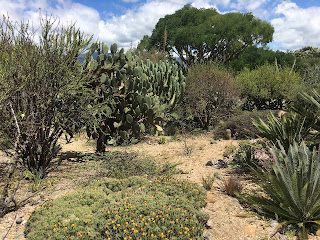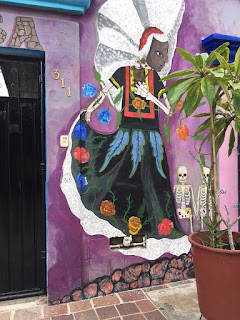Judy. After I sent some photos to a friend, she wrote and asked me
about the city of Oaxaca. In her imagination, it is a small town, a pueblo, made up of mud brick houses and
a great deal of poverty. It’s a fair assumption; we know so little about cities
outside what we read in the daily news, especially in Mexico. Most of us who
have visited have seen only border towns or resorts, so a city in central
Mexico can be beyond our imaginations, especially one nestled in a valley where
two mountain ranges come together.
 |
| Oxaca sign by the Templo |
First of all, it’s
not tiny. In 2010 the population was listed at 255,000. It’s noted for its
colonial architecture, much of it using a pale green-colored volcanic stone.
There are dozens of old churches, some from the sixteenth century. In particular,
the Templo of Santo Domingo is huge, beautiful, and popular. I’m told there is
a months-long waiting list to use it for weddings. The Zocalo, or town square, is surrounded by old buildings as well as
booths where locals sell their wares: colorful shirts, dresses, skirts, silver,
pottery, etc. Interestingly, many of the local women wear these; they’re not
just for tourists and expats. There’s been a soap opera filming here, and I’m
told it’s being used more and more as a set because of the beautiful colonial
buildings.



Oaxaca has an
interesting past. Many indigenous tribes were here, particularly the Zapotec,
who populate pueblos nearby. These
people were the first to cultivate corn and develop chocolate. They have
created beautiful silver jewelry from the ore here, and their black pottery
from the dark clay is famous. There are ancient ruins here in the mountains of
government and religious centers. It is a very old culture.
 |
| Adobe, limestone, & stucco |
Many of the
buildings in the center of town ARE adobe, but covered with stucco. It’s easy
to see the adobe underneath because of the earthquakes we’ve been experiencing.
Daily we see workers repairing these buildings. Some are built with cinderblock
and stucco, and most of the newer buildings use rebar for stabilization during an
earthquake. We recently met at woman who was terrified after our last 4.7 quake
because she lives alone in a 200-year-old building. I would say it’s worth being
scared.
 |
| Door to our Airbnb |
 |
| Inside the door |
Walking down the
streets the houses are closed off—not very inviting. But if you happen by when
a door opens, you often see a lush patio surrounded by rooms—the
Spanish/Moorish influence. A Miscellanea (convenience store) might only be recognized
because the door is open. It is, in a word, quaint.
 |
| Our rooftop patio |
Streets and
sidewalks are not so quaint. They’re often filled with potholes, elevation
changes, broken concrete, and metal pieces randomly sticking up from the
walkways. Recently I read through a guidebook that mentioned these, reminding
us to watch our step. Traffic can be rough, which means crossing the street is
iffy—but not as scary as Cambodia was.
 I walk twenty
minutes to my well-taught yoga class at Prana Yoga, and seven minutes to a local spa where I got a killer hour-and-a-half massage, complete with wine at the end. There are high-end dress shops (modern) and thrift stores, just like in any major city. En Via, the foundation that sponsors our English classes, has its offices fifteen minutes away in a gorgeous gated compound, which houses the Cultural Institute. The grounds are green and lush, and the buildings are clean and fresh, built in the colonial style.
I walk twenty
minutes to my well-taught yoga class at Prana Yoga, and seven minutes to a local spa where I got a killer hour-and-a-half massage, complete with wine at the end. There are high-end dress shops (modern) and thrift stores, just like in any major city. En Via, the foundation that sponsors our English classes, has its offices fifteen minutes away in a gorgeous gated compound, which houses the Cultural Institute. The grounds are green and lush, and the buildings are clean and fresh, built in the colonial style.
The nearby park is
used all the time: kids skateboard or skate around the fountain, lovers kiss in
the shadows, teens giggle on their way home from school, and food vendors ply
their wares. On Fridays the perimeter is lined with a traveling market, where
you can get tacos for about .75 each, while you share a table and condiments
with whoever sits down. Saturdays there’s an open-air Zumba class that’s packed
with dancers.
 |
| Parque El LLano |
Speaking of
dancers, there are Salsa, Cumbia, Rumba, and other dances taught at Candela,
which we pass when we head downtown. The students are glorious to watch.
We can spend $60
on a meal with wine in an upscale and beautiful restaurant, or eat a cup of esquites (corn soup) we buy from a
street vendor for .90 each. Once we stopped at a bar to get out of the rain and
bought two beers ($2), and the waiter brought us each a bowl of soup. There is
terrific food in all price ranges.
There are big
grocery stores, but we do most of our shopping at the Mercado down the street. However, eating out is so cheap that we
usually eat at least one meal per day out. By the way, we do eat the fruits and
veggies, and some street food, and have yet to get sick.
However, lest you
think we are living in a little pueblo,
once you step outside the Centro, the
scenery changes. Our bus to Tlachochahuaya, the village where we teach, takes us
past modern buildings on good roads. (The bus, however, is a collectivo, an old bus with no
schedule—a conductor stands by the driver and yells out the name of the town
they’re headed to, then takes your ten pesos when you get off.) Last Friday evening we attended a movie at
the Oaxaca Film Festival, located in a mall beside a big department store
called Fabrique en France. I peered
in the door and saw makeup counters: Mac, Estee’ Lauder, etc. Things were
definitely more modern there.
There are many
expats (Ted has a blog on that), and some tourists, though that number is
expected to go through the roof closer to Dia
de los Muertos. We attend church in an American mission, and on Saturdays
go to the Oaxaca Lending Library to practice Spanish in an intercambio—one hour in English and one in Spanish. My second week of speaking was definitely better, and we both can tell our Spanish is rudimentary but
improving. We try not to mix too much with other Americans, basically because
we want to practice the language here. The Oaxaquenos are friendly and helpful, especially
if we greet them in their own language.
Living here is not
always easy. Our big jug of drinking water needs to be replaced soon; in most public
buildings you must put used toilet paper in a trash can, not flush it; we’re
not quite used to the soft, sweet bread. But to us, it’s worth it. Big time.




















































